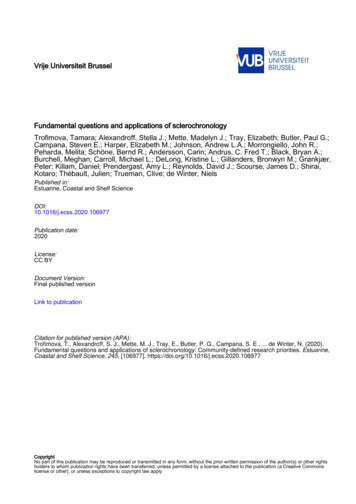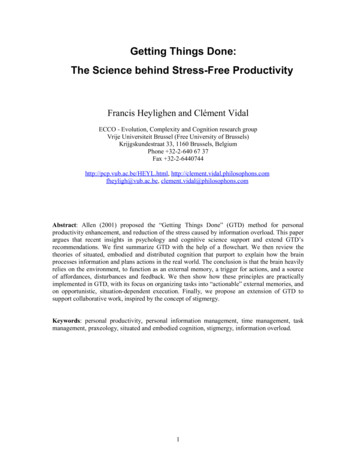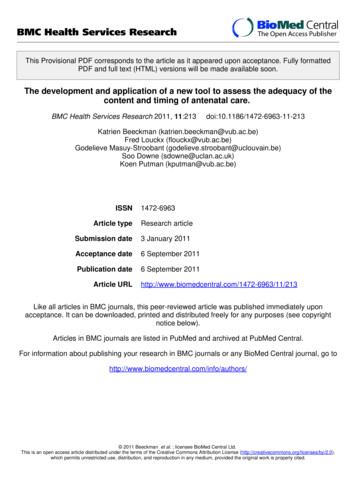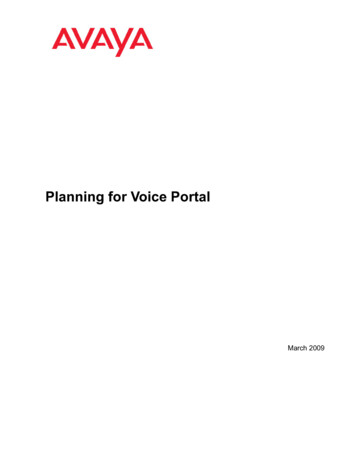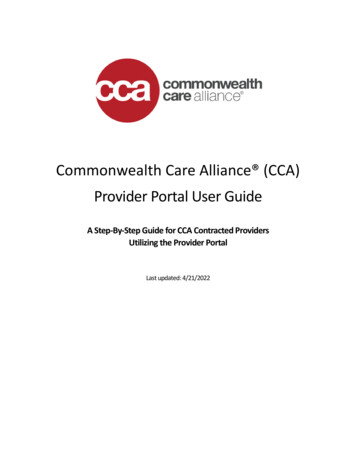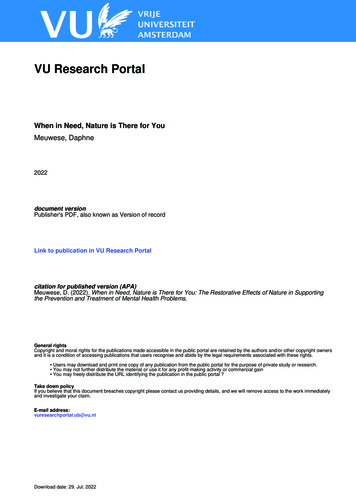
Transcription
VU Research PortalWhen in Need, Nature is There for YouMeuwese, Daphne2022document versionPublisher's PDF, also known as Version of recordLink to publication in VU Research Portalcitation for published version (APA)Meuwese, D. (2022). When in Need, Nature is There for You: The Restorative Effects of Nature in Supportingthe Prevention and Treatment of Mental Health Problems.General rightsCopyright and moral rights for the publications made accessible in the public portal are retained by the authors and/or other copyright ownersand it is a condition of accessing publications that users recognise and abide by the legal requirements associated with these rights. Users may download and print one copy of any publication from the public portal for the purpose of private study or research. You may not further distribute the material or use it for any profit-making activity or commercial gain You may freely distribute the URL identifying the publication in the public portal ?Take down policyIf you believe that this document breaches copyright please contact us providing details, and we will remove access to the work immediatelyand investigate your claim.E-mail address:vuresearchportal.ub@vu.nlDownload date: 29. Jul. 2022
Daphne Meuwese is a researcher and psychologist.She was born and raised in Lelystad, the Netherlands.She began her academic studies at WageningenUniversity and Research Centre (WUR) with Forest andNature Conservation. During her time there she wasinterested to learn more about Nature and MentalHealth, for which she sought out to study Psychologyat the University of Amsterdam. After completing aBachelor of Science degree for both study programsshe followed by completing a Master of Science degreein Healthcare Psychology, also at the University ofAmsterdam. Directly after graduation in 2016 shewas able to start as a research assistant for thedepartment of Clinical Psychology at the VU University.Here she got the chance to combine her educationalbackgrounds in a PhD project about Nature and MentalHealth as she had strived for. During her first yearas a graduate student she started to miss clinicalpractice, . Before long she was able to combine thework for her PhD project with work in clinical practice.First at Wagenaar Psychotherapie and from February2019 onwards at Altrecht in Utrecht. Her interestsand qualities within the field of psychotherapy aremostly experiential in nature. She is in trainingto become a Cognitive Behavioral Therapist(CBT), an Emotionally Focused Therapist(EFT) and a Schema Focused Therapist (SFT).Since January 2022 she has started thepost-master education program towardsbecoming a healthcare psychologist (GZpsycholoog). Her research interestsare geared towards mental healthcare and more specifically towardsstudying people in context of theirenvironment. Such as the physicalenvironment, but also the socialenvironment in EFT relationshipand family interventions.
WHEN IN NEED,NATURE IS THERE FOR YOUThe Restorative Effects of Nature in Supporting thePrevention and Treatment of Mental Health ProblemsDaphne Meuwese
Title:WHEN IN NEED, NATURE IS THERE FOR YOUThe Restorative Effects of Nature in Supporting the Prevention and Treatment of Mental Health ProblemsCopyright Daphne Meuwese, Amsterdam, the Netherlands, 2022Design: Wolf Art Studio, Jeroen van LeusdenCover design: Wolf Art Studio, Jeroen van LeusdenAll rights reservedNo part of this publication may be reproduced, stored in a retrieval system, or transmitted in any form or by anymeans, electronic, mechanical, photocopying, recording, or otherwise, without written permission of the author.2
VRIJE UNIVERSITEITWHEN IN NEED, NATURE IS THERE FOR YOUThe Restorative Effects of Nature in Supporting thePrevention and Treatment of Mental Health ProblemsACADEMISCH PROEFSCHRIFTter verkrijging van de graad Doctor aande Vrije Universiteit Amsterdam,op gezag van de rector magnificusprof.dr. C.M. van Praag,in het openbaar te verdedigenten overstaan van de promotiecommissievan de Faculteit der Gedrags- en Bewegingswetenschappenop donderdag 27 januari 2022 om 11.45 uurin een bijeenkomst van de universiteit,De Boelelaan 1105doorDaphne Meuwesegeboren te Lelystad3
4promotor:prof.dr. A.C. Krabbendamcopromotoren:dr. J. Maasdr. K. Dijkstrapromotiecommissie:prof.dr. M. van Vugtprof.dr. A. van Stratendr. S. de Vriesprof.dr. Y.A.W. de Kortprof.dr. J. Schuit
ContentsChapter 1General Introduction 7References 15Chapter 2Beating the Blues by Viewing Green:Depressive Symptoms Predict Greater RestorationFrom Stress and Negative Affect After Viewing a Nature Video 212.1 INTRODUCTION 222.2 STUDY 1 262.3 STUDY 2 332.4 GENERAL DISCUSSION 38References 43Chapter 3Viewing Nature Lets Your Mind Run Free:Three Experiments About the Influence of Viewing aNature video on Cognitive Coping with Psychological Distress 493.1 INTRODUCTION 503.2 STUDY 1 543.3 STUDY 2 603.4 STUDY 3 643.5 GENERAL DISCUSSION 68References 72Chapter 4How do we Cope with Stress While Viewing Nature?A Lab Experiment 774.1 INTRODUCTION 784.2 STUDY DESCRIPTION 814.3 GENERAL DISCUSSION 87References 90Chapter 5The Value of Nature During Psychotherapy:A Qualitative Study of Client Experiences 955.1 INTRODUCTION 965.2 STUDY DESCRIPTION 985.3 GENERAL DISCUSSION 108References 112Chapter 6General Discussion 117References 126Summary 131Appendices 137Dankwoord/Acknowledgements 153Contents When in need, nature is there for you5
“So it begins”LOTR, The Two Towers, 2:46:41
Chapter1GENERALINTRODUCTION
This dissertation was written during several COVID-19 lockdowns in which I wasalso working as a therapist. During a video session one of my clients mentioned that duringthese incredibly stressful and insecure times with many restrictions, daily walks in the localpark and driving out towards the dunes had become increasingly important to him. Outthere in nature he described finding a sense of calmness or even peacefulness. It turns outthat he is not alone. Visiting local green spaces, and exposure to nature in general havebecome increasingly important in maintaining wellbeing and mental health during lockdownrestrictions (Lõhmus et al., 2021; Pouso et al., 2021; Ribeiro et al., 2021). In part this canprobably be attributed to the limited options for restorative activities during lockdown times.However, it can also be attributed to the value of nature in particular. Natural surroundingsare known to have restorative qualities (Collado, Staats, Corraliza, & Hartig, 2017), suchas recovery from stress, mood enhancement, and replenishment of attention (for reviewssee: Kondo, Jacoby, & South, 2018; McMahan, & Estes, 2015; Stevenson, Schilhab, &Bentsen, 2018; Twohig-Bennett, & Jones, 2018). These restorative qualities of nature maycontribute to the prevention and treatment of mental health problems and promote wellbeing (Cooley et al., 2020; Shanahan et al., 2019).Before proceeding, it is important to clarify how nature and restoration are definedfor the purpose of this dissertation. Nature in the present dissertation encompasses nonthreatening natural elements or larger nature areas that people generally encounter in dailylife. These include but are not limited to the following: (potted) plants, flowers, trees, andother kinds of vegetation (Hartig et al., 2011). The present dissertation mostly used (videomaterial of) areas where many such elements of nature are present, which include but arenot limited to for example parks and forests. These natural environments are compared withbuilt environments in the present dissertation, which may include elements of nature (suchas flowers or trees), but where built elements are more predominantly present. The terms‘nature’ and ‘natural environment’ thus both denote the setting where natural elementsare most predominantly present and will be used somewhat interchangeably. Building onUlrich et al. (1991), the term ‘restoration’ is used in the present dissertation to denoterecovery from and/or improvement of one’s affective state, particularly, the down-regulationof negative affective states (including feelings of stress) and up-regulation of positive affect.Based on the increasing knowledge of beneficial mental health effects of nature,preventive and clinical initiatives that utilize nature are booming (Cooley et al., 2020; Mantler,& Logan, 2015; Shanahan et al., 2019). With regard to preventive initiatives for example,plants are brought into the office to mitigate workplace stress (Gritzka et al., 2020; Sadick,& Kamardeen, 2020); green schoolyards are implemented at elementary schools (Bates,Bohnert, & Gerstein, 2018) and plant walls are put up in classrooms of secondary andtertiary education (Van den Bogerd et al., 2020) to improve well-being of students; andmicro breaks with nature videos or virtual reality are deployed to reduce stress and negativeaffect at home (Valtchanov, Barton, & Ellard, 2010). With regard to clinical initiatives, nature isfor example implemented in waiting rooms (Beukeboom, Langeveld, & Tanja-Dijkstra, 2012;Largo-Wight, O’Hara, & Chen, 2016) or wards (Ulrich et al., 2018) of (mental) healthcarefacilities, in the therapist’s office (Augustin, & Morelli, 2017), and in nature-based therapymodules (Cooley et al., 2020; Maund et al., 2019).8
Aim and Research Questions of this Dissertation1The above mentioned initiatives and the underlying research have inspired themain aim of the present dissertation: to further the understanding of the restorative effectsof exposure to nature in order to inform both preventive and clinical interventions thatconsider nature as a supportive environment. As it seems plausible that how someonefeels influences how they experience the world, including the natural world (Beute, & deKort, 2018; Moser, & Uzzell, 2003; Roe, & Aspinall, 2011), the restorative effects of naturecould differ for certain personal circumstances. Therefore, to inform preventive and clinicalmental health interventions about such moderating factors, the first research question ofthe present dissertation was: do the restorative effects of nature differ between people in adifferent mental health state?Also, knowing that exposure to nature leads to restoration raises the questionby which psychological mechanism this occurs. More specifically, it raises the questionof how people cope with what they are restoring from (e.g. an aversive affective state)and whether exposure to nature influences this process. Coping is of specific interest topreventive and clinical mental health interventions, because coping entails the strategiesthat are employed to manage social, physical, and emotional challenges (Folkman, 2011;Lazarus, 1993). Therefore, the second research question of the present dissertation wasabout this potentially underlying mechanism: does exposure to nature influence coping?When integrating research question one about the personal circumstancesthat influence restoration and research question two about whether exposure to natureinfluences coping, one can also wonder whether it matters what someone is restoring from,e.g. what they need to cope with (Moser, & Uzzell, 2003). Therefore, the present dissertationalso has special attention for personal circumstances (i.e. which aversive affective statesomeone recovers from) that vary between studies about coping. That is why the thirdresearch question was: does a different aversive affective state impact whether exposure tonature influences coping?Studying these research questions contributes to the further understanding of therestorative effects of exposure to nature, however they do not necessarily explain what aperson experiences while in the natural environment. To gain a more in depth understandingof nature during a recovery process, the fourth research question was: what happensto peoples’ inner worlds during contact with nature? See Figure 1.1 for a more detailedschematic representation of how this dissertation aims to further the understanding of therestorative effects of nature.In what follows, I first describe the theoretical perspectives and previous researchupon which the present research was built and conclude with an outline of the presentdissertation.Chapter 1 General Introduction9
Psychological mechanisms thatmight (in part) underly therestorative effects of nature:Cognitive coping (Chapter 3 and 4)Exploratively (Chapter 5)Induction of aversive affective state:Nature exposure:Restoration:Feelings of stress (Chapter 2 and 4)Psychological distress (Chapter 3)Viewing nature (Chapter 2 - 4)Walking in nature (Chapter 5)Feelings of stress (Chapter 2)Positive and negative affect(Chapter 2 and 4)Moderator that might constrainor bolster the restorative effectsof exposure to nature:Depressive symptoms (Chapter 2)How the restorative process is experienced:Inner world experiences of clients (Chapter 5)Figure 1.1 Overview of how the present dissertation aims to further the understanding ofthe restorative effects of nature.Theoretical FrameworkThis dissertation is based on the vast body of research that provides evidencefor the restorative effects of exposure to nature (for reviews see: Hartig, Mitchell, de Vries,& Frumkin, 2014; Kondo, Jacoby, & South, 2018; McMahan, & Estes, 2015; Stevenson,Schilhab, & Bentsen, 2018; Twohig-Bennett, & Jones, 2018). These restorative effects ofnature are most often explained by two leading psychological scientific theories: StressReduction Theory (SRT; Ulrich et al., 1991) and Attention Restoration Theory (ART; Kaplan,& Kaplan, 1989). Stress Reduction Theory is most often used to describe the affectiverestorative benefits of nature (Kondo, Jacoby, & South, 2018; McMahan, & Estes, 2015). Itposits that exposure to nature or natural elements elicit a direct positive affective responsethat facilitates recovery from stress (Ulrich et al., 1991). According to SRT, humans havea predisposition to react with a positive affective response to a “safe” natural environmentbecause the human species has evolved in nature for most of its existence and the “safe”natural environments had adaptive value. Built elements, compared to natural elements, arerelatively new in the timeline of human species existence. Consequently, an ingrained instinctlike assessment can be rapidly made for natural environments while built environments takemore effort to assess (Korpela, Klemettilä, & Hietanen, 2002, Ulrich, 1983). This distinctionin the effort it takes to assess these environments results in a greater restorative potentialfor natural environments compared to built environments (Korpela, Klemettilä, & Hietanen,2002, Ulrich, 1983).10
Attention Restoration Theory is most often used to describe the cognitive restorativebenefits of nature (Stevenson, Schilhab, & Bentsen, 2018). According to ART, intrinsicallyinteresting natural elements engage attention in an effortless manner (soft fascination),allowing the directed attention system to rest and replenish (Kaplan, & Kaplan, 1989). Thedirected attention system is used for tasks that require focus or at least effortful attention,such as planning, solving problems and inhibiting distractions. The directed attentionsystem can get depleted, resulting in attention fatigue and hence a need for restoration.Built environments are more often the environments where these tasks that require effortfulattention are conducted. In addition to soft-fascination, ART posits that nature restoresattention fatigue by providing a sense of being away from daily hassles. Moreover, thefeeling of being part of something greater than oneself and a compatibility between what aperson needs and what nature has to offer construe a healing experience when exposedto nature according to ART (Kaplan, & Kaplan, 1989). Again, the distinction in the effortit takes to engage with environments results in a greater restorative potential for naturalenvironments compared to built environments.Even though SRT and ART are the leading theories in the field of restorativeenvironments research, these theories are limited regarding their ability to fully explain thepsychological mechanisms that underly the restorative effects of exposure to nature (Egner,Sütterlin, & Calogiuri, 2020; Joye, & Van den Berg, 2011; Kardan et al., 2015; Kuo, 2015Korpela, Ylén, Tyrväinen, Silvennoinen, 2008; Richardson, McEwan, Maratos, & Sheffield,2016; Richardson, 2019). Therefore, the present dissertation focused on gaining moreinsight in psychological mechanisms that might (in part) underly the restorative effects ofnature. One likely, but understudied, psychological mechanism underlying the restorativeeffects of nature is cognitive coping. Nature exposure has been studied as a coping strategybefore, however this entails the behaviour of seeking out nature as a means to cope with anaversive affective state (Berto, 2014; Gulwadi, 2006; Hartig et al., 2011). Rather, the presentresearch aims to understand the cognitive coping that is deployed during nature exposure.Cognitive coping is important as it helps people to deal with, work through, and processdifficult thoughts and emotions which in the end helps to maintain wellbeing and mentalhealth (Folkman, 2011; Lazarus, 1993).The primary aversive affective states of interest in the present dissertation areself-reported feelings of stress, negative affect, and psychological distress. These affectivestates where chosen because meta-analyses have concluded that the most robust findingsof nature’s restorative effects have been found on such affective outcome measures,(Kondo, Jacoby, & South, 2018; McMahan, & Estes, 2015; Twohig-Bennett, & Jones,2018). In addition, these affective outcome measures are related to well-being and mentalhealth (Kondo, Jacoby, & South, 2018; McMahan, & Estes, 2015; Twohig-Bennett, & Jones,2018). Psychological distress has additional value for clinical practice because psychologicaldistress constitutes the struggles with difficult thoughts and feelings about the self and istherefore more directly associated with psychopathology (Haddadi, & Besharat, 2010; Lin,& Yusoff, 2013; Ridner, 2004).Chapter 1 General Introduction111
Meta-analyses about the restorative effects of nature also revealed that manyoriginal research studies had the following limitations: low statistical power, not takinginto account potential baseline differences, and no experimental manipulation to inducea need for restoration before the environmental exposure (Kondo, Jacoby, & South, 2018;McMahan, & Estes, 2015; Stevenson, Schilhab, & Bentsen, 2018). The current worktherefore aims to contribute by including experiments that have sufficient statistical power,that account for potential baseline differences and include an experimental induction tocreate a need for restoration before environmental exposure.Lab experiments have the benefit of a well-controlled research design that enablesthe study of causal effects with sufficient statistical power (Breakwell, Hammond, Fife-Shaw,& Smith, 2006). Therefore they are particularly suited to study novel topics. In the experimentsin the present dissertation nature imagery (i.e. nature vs. built videos) is used to study therestorative effects of nature. Even though the effect size is larger for studies that exposeparticipants to real nature, lab studies using nature imagery (e.g. photographs or videos)show robust effects as well (McMahan, & Estes, 2015; Stevenson, Schilhab, & Bentsen,2018). A limitation of lab studies is that the generalizability to daily life and clinical practiceis limited (Breakwell, Hammond, Fife-Shaw, & Smith, 2006). Therefore, the present workaimed to contribute by studying inner world experiences regarding nature in a qualitativemanner, with actual clients who received individual outpatient psychotherapy in actual nature.This is an important study to help bridge the science-practice gap. Furthermore, meaningand depth regarding this human-nature relationship during psychotherapy in nature mighthelp further our understanding of underlying psychological processes in the field of clinicalenvironmental psychology. A qualitative research design and phenomenology in particularwas chosen for the purpose of studying clients’ inner world experiences regarding naturebecause it is uniquely suited to provide a deep understanding of the lived experience of aphenomenon (Finlay, 2012; Finlay, 2014).A Transactional PerspectiveThe two leading theories in restorative environments research (i.e. SRT and ART)are based on an a psycho-evolutionary perspective, which means that “safe” nature and itsrestorative potential were important for survival during the evolution of the human species(Kaplan & Kaplan, 1989; Ulrich et al., 1991). Consequently, these leading theories implya deterministic perspective of human-environment relationships, meaning that naturalenvironments elicit a uniform response across different individuals (Bowler, Buyung-Ali,Knight, & Pullin, 2010; Hartig et al., 2014). A transactional perspective however, suggeststhat people’s responses to their environment are more complex than traditional theorieshave assumed (Altman, & Rogoff, 1987; Araújo et al., 2019; Moser & Uzzell, 2003).A transactional perspective on environmental psychology describes adevelopmental perspective of human-environment transactions where people are formedby their environment and the environment is formed by people (Altman, & Rogoff, 1987;Araújo et al., 2019; Moser & Uzzell, 2003). For example, when people feel weighed downby personal struggles and they experience a sense of calmness in nature, this could incitethe behaviour of bringing more natural elements into their home, thereby changing their12
home environment. According to a transactional perspective, human and environment arethus inherently intertwined in a dynamic and ongoing relationship where the one can onlybe defined in relation to the other (Altman, & Rogoff, 1987; Araújo et al., 2019; Moser &Uzzell, 2003). Aspects within this human-environment interplay can be studied, however,it is important to acknowledge that these aspects exist in a larger temporal, spatial andpersonal context.Restorative environments research involves the aspect of the human-naturerelationship that considers how the environment affects a person (Hartig, Catalano, &Ong, 2007; Kondo, Jacoby, & South, 2018; McMahan, & Estes, 2015; Roe, & Aspinall,2011; Twohig-Bennett, & Jones). A transactional perspective suggests that this restorativeexperience can vary depending on certain environmental and personal circumstances(Altman, & Rogoff, 1987; Araújo et al., 2019; Moser & Uzzell, 2003). More specifically,a natural environment (relative to a built environment) does not elicit the same kind ofrestorative response between different people or within a person over time (Beute, & deKort, 2018; Von Lindern, Lymeus, & Hartig, 2017; Roe, & Aspinall, 2011). Research so farhas focused on environmental factors like exposure type (e.g. real vs. digital nature; walkingvs. viewing nature), exposure duration, and weather conditions (Hartig, Catalano, & Ong,2007; McMahan, & Estes, 2015), or personal factors like age, education level and sex (Bolte,Nanninga, & Dandolo, 2019; Ruijsbroek et al., 2017). Clinically relevant personal factorsthat can vary between people and within a person over time however, have received fewerattention as potential moderators in restorative environments research (Kondo, Jacoby, &South, 2018; Von Lindern, Lymeus, & Hartig, 2017; McMahan, & Estes, 2015).One important clinically relevant personal factor that might either blunt or sensitizea person for the restorative effects of nature, and thus might be a potential moderator, isformed by the presence of depressive symptoms (Vilagut, Forero, Barbaglia, & Alonso,2016). Depressive symptoms tend to differ substantially between individuals and overtime (Vilagut et al., 2016). A hallmark of depression is anhedonia, a reduced motivation orability to experience pleasure (Treadway & Zald, 2011). Thus, as far as restorative effectsof nature are due to increases in positive affect (Richardson et al., 2016; Ulrich et al.,1991), one might expect fewer restorative effects from exposure to nature for people withelevated depressive symptom levels. On the other hand, people with depressive symptomsexperience heightened psychological distress, an aversive state that people are motivatedto alleviate (Suls, Davidson, & Kaplan, 2010). This higher need for restoration may leadpeople in a depressed state to become more attuned to affordances of the environment thatare comforting and stress-reducing (Beute, & de Kort, 2018; Roe, & Aspinall, 2011). Thereis also special attention in the present dissertation for differences in personal circumstances,specifically the circumstances that trigger the need for restoration. With a transactionalperspective in mind, the restorative experience of nature might depend on the affectivestate someone is in (i.e. psychological distress vs. feelings of stress). Therefore, differentexperimental manipulations were used to induce these different affective states.Chapter 1 General Introduction113
Dissertation OutlineThe present dissertation aimed to further our understanding about the restorativeeffects of exposure to nature to inform both preventive as well as treatment interventionsthat consider nature as a supportive environment. The first empirical part of this dissertationconsists of (lab) experiments (Chapter 2-4). These have the benefit of a well-controlledresearch design. The final empirical chapter of this dissertation used a qualitative researchdesign (Chapter 5), which has the benefit of being able to study the lived experienceof a phenomenon and can consequently assign depth and meaning to the quantitativeresults. Research question one (do the restorative effects of nature differ between peoplein a different mental health state?) was examined in Chapter 2. Research question two(does exposure to nature influence coping?) was investigated in Chapter 3 and 4. Researchquestion three (does a different aversive affective state impact whether exposure to natureinfluences coping?) was studied by comparing Chapter 3 and Chapter 4. Finally, researchquestion four (what happens to peoples’ inner worlds during contact with nature?) wasexamined in Chapter 5.Both Chapter 2 and Chapter 4 were based on a SRT paradigm and henceforthused stress as the experimental induction before environmental exposure. Moreover,affective outcome measures were assessed (Chapter 4 also included a cognitive measure).Chapter 3 induced psychological distress and solely assessed a cognitive measure, whichis why ART is more prominent in that chapter. Chapter 2 through 4 included samples fromthe ‘‘healthy’’ population, Chapter 5 studied a clinical sample in a clinical setting.To specify: Chapter 2 describes two lab studies that investigated a clinicallyrelevant personal characteristic that might constrain or bolster the effectiveness of therestorative benefits of exposure to nature: depressive symptoms (Hartig, Catalano, & Ong,2007; McMahan, & Estes, 2015; Vilagut et al., 2016). Chapter 3 studied the psychologicalprocess of cognitive coping, that is a potential underlying mechanism for the restorativebenefits of exposure to nature. This chapter includes three lab studies that examined whethernature influences cognitive coping with psychological distress. Chapter 4 also studied thepsychological process of cognitive coping but with a different experimental manipulation toinduce a capacity for restoration before environmental exposure. This chapter contains alab study that examines whether nature influences cognitive coping with feelings of stress.Chapter 5 examined clients’ experiences of nature during psychotherapy by means of aphenomenological qualitative study with clients who were treated for a DSM-5 (Diagnosticand Statistical Manual of Mental Disorders, 5th ed.; American Psychiatric Organization,2013) recognized mental disorder by
as a graduate student she started to miss clinical practice, . Before long she was able to combine the work for her PhD project with work in clinical practice. First at Wagenaar Psychotherapie and from February 2019 onwards at Altrecht in Utrecht. Her interests and qualities within the field of psychotherapy are mostly experiential in nature.
